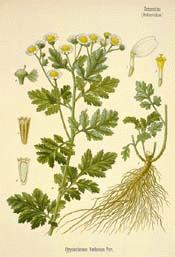
Botanical.com Home Page

|
Feverfew
(Tanacetum parthenium
printed as
Chrysanthemum Parthenium) Pers.
Click on graphic for larger image
|
Feverfew
Botanical: Chrysanthemum Parthenium (BERNH.)
Family: N.O. Compositae
---Synonyms---Pyrethrum Parthenium (Sm.). Featherfew. Featherfoil. Flirtwort. Bachelor's Buttons.
---Part Used---Herb.
---Description---Feverfew (a corruption of Febrifuge, from its tonic and fever-dispelling properties) is a composite plant growing in every hedgerow, with numerous, small, daisy-like heads of yellow flowers with outer white rays, the central yellow florets being arranged on a nearly flat receptacle, not conical as in the chamomiles. The stem is finely furrowed and hairy, about 2 feet high; the leaves alternate, downy with short hairs, or nearly smooth-about 4 1/2 inches long and 2 inches broad - bipinnatifid, with serrate margins, the leaf-stalk being flattened above and convex beneath. It is not to be confounded with other wild chamomile-like allied species, which mostly have more feathery leaves and somewhat large flowers; the stem also is upright, whereas that of the true garden Chamomile is procumbent. The delicate green leaves are conspicuous even in mild winter. The whole plant has a strong and bitter smell, and is particularly disliked by bees. A double variety is cultivated in gardens for ornamental purposes, and its flower-heads are sometimes substituted for the double Chamomile.
Country people have long been accustomed to make curative uses of this herb, which grows abundantly throughout England. Gerard tells us that it may be used both in drinks, and bound on the wrists is of singular virtue against the ague.
Pyrethrum is derived from the Greek pur (fire), in allusion to the hot taste of the root.
[Top]
---Cultivation---Feverfew is a perennial, and herbaceous in habit. When once planted it gives year after year an abundant supply of blossoms with only the merest degree of attention. Planting may be done in autumn, but the best time is about the end of April. Any ordinary good soil is suitable, but better results are obtained when well-drained, and of a stiff, loamy character, enriched with good manure. Weeding should be done by hand, the plants when first put out being small might be injured by hoeing.
There are three methods of propagation: by seed, by division of roots and by cuttings. If grown by seed, it should be sown in February or March, thinned out to 2 to 3 inches between the plants, and planted out early in June to permanent quarters, allowing a foot or more between the plants and 2 feet between the rows, selecting, if possible, a showery day for the operation. They will establish themselves quickly. To propagate by division, lift the plants in March, or whenever the roots are in an active condition, and with a sharp spade, divide them into three or five fairly large pieces. Cuttings should be made from the young shoots that start from the base of the plant, and should be taken with a heel of the old plant attached, which will greatly assist their rooting. They may be inserted at any time from October to May. The foliage must be shortened to about 3 inches, when the cuttings will be ready for insertion in a bed of light, sandy soil, in the open. Plant very firmly, surface the bed with sand, and water in well. Shade is necessary while the cuttings are rooting.
Keep a good watch at all times for snails, slugs and black fly. For the latter pest, try peppering the plants; for the others use soot, ashes or lime. Toads will keep a garden free of slugs.
'A few pots placed on their sides may be dotted about the garden, and it will be found that the toads will sit in these when they are not hunting around for their prey. The creatures are not at all likely to leave the garden, seeing that if the supply of slugs runs short they will turn their attention to all kinds of insects.' (S. L. B.)
---Medicinal Action and Uses---Aperient, carminative, bitter. As a stimulant it is usefulas an emmenagogue. Is also employed in hysterical complaints, nervousness and lowness of spirits, and is a general tonic. The cold infusion is made from 1 OZ. of the herb to a pint of boiling water, allowed to cool, and taken frequently in doses of half a teacupful.
A decoction with sugar or honey is said to be good for coughs, wheezing and difficult breathing. The herb, bruised and heated, or fried with a little wine and oil, has been employed as a warm external application for wind and colic.
A tincture made from Feverfew and applied locally immediately relieves the pain and swelling caused by bites of insects and vermin. It is said that if two teaspoonfuls of tincture are mixed with 1/2 pint of cold water, and all parts of the body likely to be exposed to the bites of insects are freely sponged with it, they will remain unassailable. A tincture of the leaves of the true Chamomile and of the German Chamomile will have the same effect.
Planted round dwellings, it is said to purify the atmosphere and ward off disease.
An infusion of the flowers, made with boiling water and allowed to become cold, will allay any distressing sensitiveness to pain in a highly nervous subject, and will afford relief to the face-ache or earache of a dyspeptic or rheumatic person.
---Preparations---Fluid extract: dose, 1 to 2 drachms.
See CHAMOMILE, PELLITORY, PYRETHRUM.
---Other Species---
SWEET FEVERFEW (Chrysanthemum Suaveolens) and C. maritima, found by the seashore, especially in the north, with leaves broader, more fleshy, succulent and smaller flowerheads than the Common Feverfew.
[Top]
Common Name Index
A MODERN HERBAL Home Page
Bear in mind "A Modern Herbal" was written with the conventional wisdom of the early 1900's. This should be taken into account as some of the information may now be considered inaccurate, or not in accordance with modern medicine.
© Copyright Protected 1995-2024 Botanical.com
|

